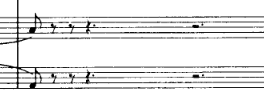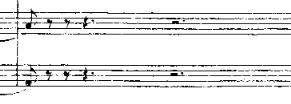Page 3 of 7
Re: 12/8 Question
Posted: 05 Oct 2015, 19:02
by N. Grossingink
Knut wrote:How do you mean this is not easily accomplished in Finale? There are options for beaming over rests and for drawing stemlets automatically.
The only problem with those options, however, is that they are global over the whole document.
That's what I meant - an extended beam over/under the eighth rests on either side of the note, only on the 4th beat.
N.
Re: 12/8 Question
Posted: 05 Oct 2015, 19:13
by erelievonen
It's not a big problem, though, because you can quite easily edit the beaming.
(For the record, I don't quite like this kind of mix of beamed and non-beamed rests within one measure.)
Re: 12/8 Question
Posted: 05 Oct 2015, 20:22
by RMK
I agree with erelievonen - stemlets would be the most clear. In that case I would go with your measure 1.
I have also seen horizontal brackets used to clarify the rhythm.
Re: 12/8 Question
Posted: 05 Oct 2015, 21:03
by pokeefe
Knut wrote:Aren't cases like this what Half stems/stemlets are for?
Hmm. Too bad the attached image didn't quote.
I think this is by far the most readable of the options. But I think it would be just as clear by making it 3/8 rather than 12/8. I'm sure there are other reasons to make it 12/8, but for the examples given, extra bar lines would clarify.
That suggestion is obviously true only if this is the standard compound 12/8. If it's an irregular grouping like 2,4,4,2 then maybe dotted bars (another pita, in my opinion) would help.
Re: 12/8 Question
Posted: 06 Oct 2015, 07:32
by OCTO
Interesting.
Here is some survey.

- Bach / Mattheus, Erbarme Dich; M9 (First Edition)
- Screen shot 2015-10-06 at 8.55.59 AM.png (11.88 KiB) Viewed 14991 times

- Bach / Mattheus, Erbarme Dich; M9 (First Edition)
- Screen shot 2015-10-06 at 8.56.14 AM.png (9.23 KiB) Viewed 14991 times

- Stravinsky / Firebird, M7. (Muzika)
- Screen shot 2015-10-06 at 9.13.47 AM.png (12.5 KiB) Viewed 14991 times

- Stravinsky / Firebird, M7. (Boosey)
- Screen shot 2015-10-06 at 9.16.20 AM.png (15.42 KiB) Viewed 14991 times

- Stravinsky / Firebird, M7. (Kalmus)
- Screen shot 2015-10-06 at 9.17.07 AM.png (14.25 KiB) Viewed 14991 times

- Stravinsky / Firebird piano arr, M14. (Schirmer)
- Screen shot 2015-10-06 at 9.18.46 AM.png (21.23 KiB) Viewed 14991 times
In this little survey we see that the old school makes separate even full

(to

+

), and this is followed by Boosey. In my opinion there are to many rests.
But definitely by default all use separate 2nd and 3rd

!
Re: 12/8 Question
Posted: 06 Oct 2015, 10:31
by Vaughan
I wouldn't move the rests. In a score, the beats won't line up. Sure it's a bit difficult situation to read, but I'd definitely follow the Boosey suggestion and use the quarter rests when they start a beat but not when they end one. Elaine Gould (p. 163) says the same. I'd also share N.'s tendency to put marks above the beats!
Re: 12/8 Question
Posted: 06 Oct 2015, 10:33
by Vaughan
I can also understand using shorter measures or avoiding 12/8 altogether and notating in 4/4 with triplets.
Re: 12/8 Question
Posted: 06 Oct 2015, 17:28
by John Ruggero
Arnold Arnstein* used the following rule: no quarter rests in 3/8, 6/8, 9/8 etc. or in the 3/8 parts of a composite meter. (He did use dotted quarter rests in these meters.) This meant that he would have notated the passage as in the first example with brackets above the notes to show the groups of three as in the attached example. The brackets were used only when there were three or four or more eighth rests in a row. For very complex music, he used beamed rests with mini stems. He used the analogous rule in 3/4, 6/8, 9/8 etc. no half rests allowed, only dotted half rests.

- 12-8-exampleB.gif (3.95 KiB) Viewed 14953 times
Arnstein was all about simplifying difficulties for the orchestral players and almost all of his "rules of thumb" can be traced back to this desire. As circumstances arise, I will mention some of his ideas, because his wisdom should not be lost, even if one disagrees with some of his ideas. In this case, he wished to banish the complexities of notes and rests in compound meters and found this simple solution.
*A music copyist for sixty-three years, from 1926-1989, Arnold Arnstein (1898-1989) held sway as the most respected copyist of serious music in the United States. He prepared the parts for orchestral and operatic works by Samuel Barber, Leonard Bernstein, Gian-Carlo Menotti, Virgil Thomson, William Schumann, Aaron Copland, John Corigliano, Alberto Ginestera, Krzystof Penderecki, Igor Stravinsky, David Amram, and many others. Works that opened both Lincoln Center (Barber’s Piano Concerto and Anthony and Cleopatra) and the Kennedy Center (Bernstein’s Mass) were handled by Arnstein and his team of copyists.
Arnstein was an editor and authority on music notation as well as a copyist. He taught music copying at Juilliard from 1960 to 1989, and a featured article about him appeared in Time Magazine. One section of a New York Times magazine article on Barber's Anthony and Cleopatra concerns Arnstein. The Music Research Division of the New York City Public Library at Lincoln Center houses the Arnstein Collection of numerous scores and parts that were still in his possession at his death in 1989.
I worked with Arnold Arnstein daily for six years as a music copyist and assistant and witnessed many consultations between “Arnie” and prominent composers who dropped by to discuss the copying of their latest work or just smooze. I also saw young, hopeful composers leave chastened and more knowledgeable than when they arrived.
Re: 12/8 Question
Posted: 06 Oct 2015, 17:32
by OCTO
John Ruggero wrote:
I worked with Arnold Arnstein daily for six years as a music copyist and assistant and witnessed many consultations between “Arnie” and prominent composers who dropped by to discuss the copying of their latest work or just smooze...
I have tried to know more about AA, WOW - must be great to be there!
Thanks for clarifying his approach. As said, as a musician I would definitely write beat points above, however if it is done by a publisher, one job less...
Re: 12/8 Question
Posted: 06 Oct 2015, 18:20
by Knut
John,
Your knowledge of Arnsteins principles are very interesting. Did he ever formulate a text with all of these? If not, that might be something for you to consider.